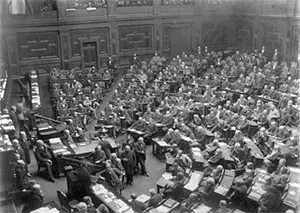The Weimar Republic: Germany's Interwar Government
Part 1: Empire to Shared Government The Weimar Republic governed Germany for 14 years after the end of World War I. Envisioned as a representative government, the Weimar Republic proved to be a bridge between two brands of authoritarianism. 
As the years of conflict progressed with no end in sight and victory seeming further and further away, the German government brought more and more of the country into the war, not only in manpower sent to the front to fight but also in industries mobilized to produce weapons of war. Workdays lengthened, and workers' health worsened. One consequence was a shortage of food. Failed harvests during the winter of 1916–1917 exacerbated this problem. Germany had few trading partners at this stage, and inflation was driving up the cost of goods bought internally. The winter was particularly harsh and, coupled with a lethal outbreak of influenza, led to many deaths. 
All of this uncertainty spilled into the government itself. The majority party in the Reichstag, the main legislative body, was the Social Democratic Party (SDP), which had claimed that right only in 1912. In the shadow of the Russian Revolution, in 1917, a large number of workers in Germany sought more of a life and set of opportunities than they were being offered. This was reflected in the Reichstag. The SDP splintered, into two groups. Party leader Friedrich Ebert presided over the existing gathering, which came to be called the Majority Social Democratic Party (MSPD). A significant number of SDP members, however, had had enough of the war and the emperor and left to form their own entity, the Independent Social Democratic Party (USPD), led by SDP Chairman Hugo Haase. 
An attempt at a Russian-style revolution in Germany did not take hold, although the country did convulse civically and politically, resulting in a form of revolution. Soldiers surrendered in large numbers as the war effort collapsed and then mutinied as the war ended. Kaiser Wilhelm II fled the country, leaving the governing to the Council of the People's Deputies, under the leadership of Ebert and Hugo Haase. This was the case on Armistice Day, November 11. The mutinies ended, although tensions seethed throughout the season of Christmas. In the new year, things calmed somewhat and a new governmental body appeared. On Jan. 19, 1919, voters elected members to a Constituent National Assembly. Familiar political parties such as the SPD and the Centre Party strove for Next page > Trouble in the Republic > Page 1, 2, 3 |
|
Social Studies for Kids
copyright 2002–2024
David White



 influence, as did the new USPD and a small handful of other new parties. The SPD garnered the most seats in the new Assembly, 165 of a possible 423. To form a government, the SPD joined with the Centre Party and one of the new parties, the German Democratic Party. The National Assembly met in the Thuringian town of Weimar (thus the name). In the new governmental blueprint, which came to be known as the Weimar Constitution, a Reich President served as head of government; taking up that role was Ebert. Leading the Assembly was Prime Minister Philipp Scheidemann (left).
influence, as did the new USPD and a small handful of other new parties. The SPD garnered the most seats in the new Assembly, 165 of a possible 423. To form a government, the SPD joined with the Centre Party and one of the new parties, the German Democratic Party. The National Assembly met in the Thuringian town of Weimar (thus the name). In the new governmental blueprint, which came to be known as the Weimar Constitution, a Reich President served as head of government; taking up that role was Ebert. Leading the Assembly was Prime Minister Philipp Scheidemann (left).

